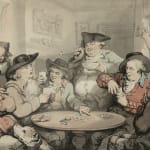Thomas Rowlandson (1756-1827)
Born in London as the son of a bankrupt merchant, Rowlandson entered the Royal Academy in 1772. He traveled to Paris in 1774 and 1777 to visit relatives and the rococo delicacy of his pen and wash drawings probably can be credited to this French connection. Rowlandson continued to travel extensively to France, Italy, Germany, and Holland, filling notebooks with a mixture of grotesque humanity and pastoral landscapes. According to the biographer of British nineteenth century caricaturists, Rowlandson’s quality of work tailed off later in life, not surprising for someone who was a gambler, dissolute and naturally lazy.[1]
In the present Countrymen and Sharpers, Rowlandson represents himself as the leading card sharper who “with blustering front, is fleecing the simple youth at cards, in defiance of his well-accepted reputation for rigid integrity”.[2] This watercolor represents the most generally recognized likeness of the artist before 1799. Rowlandson was a keen gambler as a young man and in 1789, he received from an aunt a substantial inheritance with which, according to The Gentleman’s Magazine, he subsequently “indulged his predilection for a joyous life...was known in London at many of the fashionable gaming houses, alternatively won and lost without emotion”. However, the magazine goes on to say that he was “scrupulously upright in all his pecuniary transactions, and ever avoided getting into debt”.
A young countryman is playing cards with a distinctly sharp group of companions, rather less naive than he. They appear to be seeking to encourage him to drink heartily, in the hope that his wits will be dulled to their advantage. Rowlandson, on the right in a red coat, has depicted himself as a trickster while his friend, the engraver John Keyse Sherwin (1751-1790), appears as the gullible country youth about to be relieved of his cash and his watch. The verse printed beneath Sherwin’s print makes the message clear:
Old Trusty, with his Town-made Friends,
To gentle sleep himself commends,
With Tray [his dog] upon his knees;
Whilst Tom, his son, all eager, gaping,
Expects each moment he’ll be scraping
The treasure up he sees.
Meanwhile the Harpy Tribe are plotting,
By forcing liquor, winking, nodding,
To cheat the youth unlearn’d;
Who, at his cost, will quickly find
Nor watch, nor money, left behind,
And Friends to Sharpers tum’d.
This low-life gambling scene, an all-male affair, makes a clever contrast with Rowlandson’s female-dominated Gaming Table at Devonshire House, while Karen Kilimnik’s the game table continues the narrative of British humor and gambling of the eighteenth century.
[1] Simon Houffe, The Dictionary of British Book Illustrators and Caricaturists 1800-1914, London, 1941, p. 439
[2] Grego, op.cit., p. 47, fn. 1
Provenance
M. Knoedler & Co., New York, 1913
Joseph E. Widener (1871-1943), Elkins Park, PA
Sotheby’s, London, 11 November 1993, lot 49, where acquired by
Richard Green, London
Henry Strachey Fine Art, Inc., Warminster, United Kingdom, 1995
Private collection, New York
Exhibitions
London, Royal Academy, 1787, no. 555
New York, M. Knoedler & Co., Catalogue of original Drawings by Thomas Rowlandson, 1-15 February 1913, no. 98
New York, Sotheby’s, Treasures from Chatsworth, 28 June - 18 September 2019
Literature
Joseph Grego, Rowlandson the Caricaturist: a selection from his works with anecdotal descriptions of his famous caricatures, London 1880, vol. I, p. 47
Bernard Falk, Thomas Rowlandson; His Life and Art, 1949, pp. 59, 93-5, 98
ENGRAVED
John Keyse Sherwin, Smithfield Sharpers or The Countryman Defrauded, 1787



